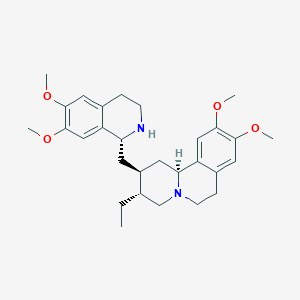| 1 |
Recurrent recessive mutation in deoxyguanosine kinase causes idiopathic noncirrhotic portal hypertension.Hepatology. 2016 Jun;63(6):1977-86. doi: 10.1002/hep.28499. Epub 2016 Mar 31.
|
| 2 |
Spironolactone FDA Label
|
| 3 |
URL: http://www.guidetopharmacology.org Nucleic Acids Res. 2015 Oct 12. pii: gkv1037. The IUPHAR/BPS Guide to PHARMACOLOGY in 2016: towards curated quantitative interactions between 1300 protein targets and 6000 ligands. (Ligand id: 2875).
|
| 4 |
Spironolactone in Covid-19 Induced ARDS
|
| 5 |
Drugs@FDA. U.S. Food and Drug Administration. U.S. Department of Health & Human Services. 2015
|
| 6 |
Drugs@FDA. U.S. Food and Drug Administration. U.S. Department of Health & Human Services.
|
| 7 |
Receptor-dependent regulation of the CYP3A4 gene. Toxicology. 2002 Dec 27;181-182:199-202.
|
| 8 |
Examination of 209 drugs for inhibition of cytochrome P450 2C8. J Clin Pharmacol. 2005 Jan;45(1):68-78.
|
| 9 |
Early identification of clinically relevant drug interactions with the human bile salt export pump (BSEP/ABCB11). Toxicol Sci. 2013 Dec;136(2):328-43.
|
| 10 |
A Gene Expression Biomarker Identifies Chemical Modulators of Estrogen Receptor in an MCF-7 Microarray Compendium. Chem Res Toxicol. 2021 Feb 15;34(2):313-329. doi: 10.1021/acs.chemrestox.0c00243. Epub 2021 Jan 6.
|
| 11 |
Effect of spironolactone on impaired fibrinolysis of hypertensive patients. Kidney Blood Press Res. 2002;25(4):260-4. doi: 10.1159/000066348.
|
| 12 |
Amiloride, spironolactone, and potassium chloride in thiazide-treated hypertensive patients. Clin Pharmacol Ther. 1980 Apr;27(4):533-43. doi: 10.1038/clpt.1980.75.
|
| 13 |
Effect of spironolactone on plasma brain natriuretic peptide and left ventricular remodeling in patients with congestive heart failure. J Am Coll Cardiol. 2001 Apr;37(5):1228-33. doi: 10.1016/s0735-1097(01)01116-0.
|
| 14 |
Spironolactone induces apoptosis in human mononuclear cells. Association between apoptosis and cytokine suppression. Apoptosis. 2006 Apr;11(4):573-9. doi: 10.1007/s10495-006-4919-3.
|
| 15 |
Evaluation of an imaging-based in vitro screening platform for estrogenic activity with OECD reference chemicals. Toxicol In Vitro. 2022 Jun;81:105348. doi: 10.1016/j.tiv.2022.105348. Epub 2022 Mar 18.
|
| 16 |
Pregnane X receptor mediates the induction of P-glycoprotein by spironolactone in HepG2 cells. Toxicology. 2011 Jul 11;285(1-2):18-24. doi: 10.1016/j.tox.2011.03.015. Epub 2011 Apr 1.
|
| 17 |
The human mineralocorticoid receptor only partially differentiates between different ligands after expression in fission yeast. FEMS Yeast Res. 2005 Apr;5(6-7):627-33. doi: 10.1016/j.femsyr.2004.12.007.
|
| 18 |
Comparison of the Hershberger assay and androgen receptor binding assay of twelve chemicals. Toxicology. 2004 Feb 15;195(2-3):177-86. doi: 10.1016/j.tox.2003.09.012.
|
| 19 |
Palmitate increases the susceptibility of cells to drug-induced toxicity: an in vitro method to identify drugs with potential contraindications in patients with metabolic disease. Toxicol Sci. 2012 Oct;129(2):346-62. doi: 10.1093/toxsci/kfs208. Epub 2012 Jun 14.
|
| 20 |
Clinical and biochemical effects of spironolactone administered once daily in primary hypertension. Multicenter Sweden study. Hypertension. 1980 Sep-Oct;2(5):672-9. doi: 10.1161/01.hyp.2.5.672.
|
| 21 |
Human paraoxonases (PON1, PON2, and PON3) are lactonases with overlapping and distinct substrate specificities. J Lipid Res. 2005 Jun;46(6):1239-47. doi: 10.1194/jlr.M400511-JLR200. Epub 2005 Mar 16.
|
| 22 |
Cell-based and cytokine-directed chemical screen to identify potential anti-multiple myeloma agents. Leuk Res. 2010 Jul;34(7):917-24. doi: 10.1016/j.leukres.2009.12.002. Epub 2010 Feb 8.
|
| 23 |
Potential role of drug transporters in the pathogenesis of medically intractable epilepsy. Epilepsia. 2005 Feb;46(2):224-35.
|
| 24 |
Metabolism of ipecac alkaloids cephaeline and emetine by human hepatic microsomal cytochrome P450s, and their inhibitory effects on P450 enzyme activities. Biol Pharm Bull. 2001 Jun;24(6):678-82.
|
| 25 |
Emetine inhibits migration and invasion of human non-small-cell lung cancer cells via regulation of ERK and p38 signaling pathways. Chem Biol Interact. 2015 Dec 5;242:25-33. doi: 10.1016/j.cbi.2015.08.014. Epub 2015 Aug 30.
|
| 26 |
Identification and Profiling of Environmental Chemicals That Inhibit the TGF/SMAD Signaling Pathway. Chem Res Toxicol. 2019 Dec 16;32(12):2433-2444. doi: 10.1021/acs.chemrestox.9b00228. Epub 2019 Nov 11.
|
| 27 |
IGF2BP1 induces neuroblastoma via a druggable feedforward loop with MYCN promoting 17q oncogene expression. Mol Cancer. 2023 May 29;22(1):88. doi: 10.1186/s12943-023-01792-0.
|
| 28 |
Apoptosis induces Bcl-XS and cleaved Bcl-XL in chronic lymphocytic leukaemia. Biochem Biophys Res Commun. 2011 Feb 18;405(3):480-5. doi: 10.1016/j.bbrc.2011.01.057. Epub 2011 Jan 20.
|
| 29 |
Pharmacologic reductions of total tau levels; implications for the role of microtubule dynamics in regulating tau expression. Mol Neurodegener. 2006 Jul 26;1:6. doi: 10.1186/1750-1326-1-6.
|
|
|
|
|
|
|


